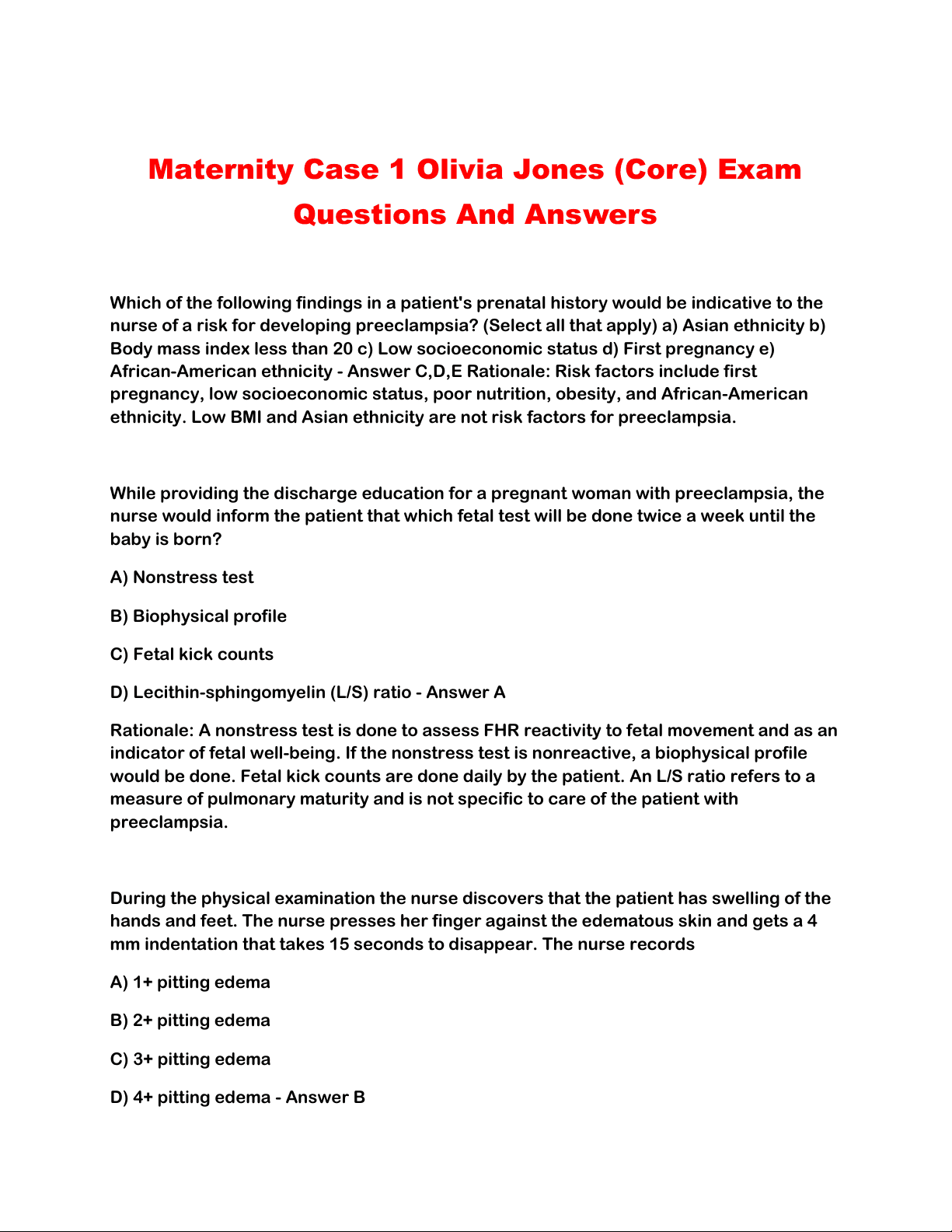
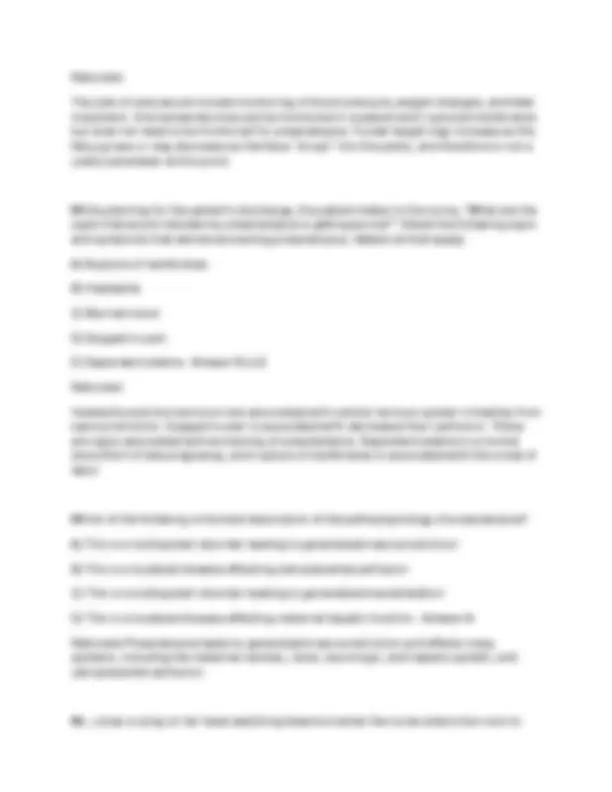
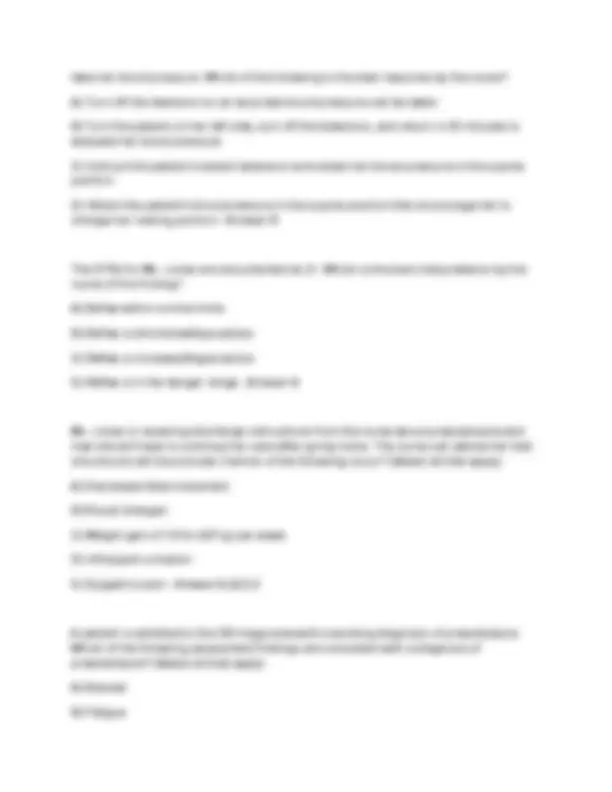
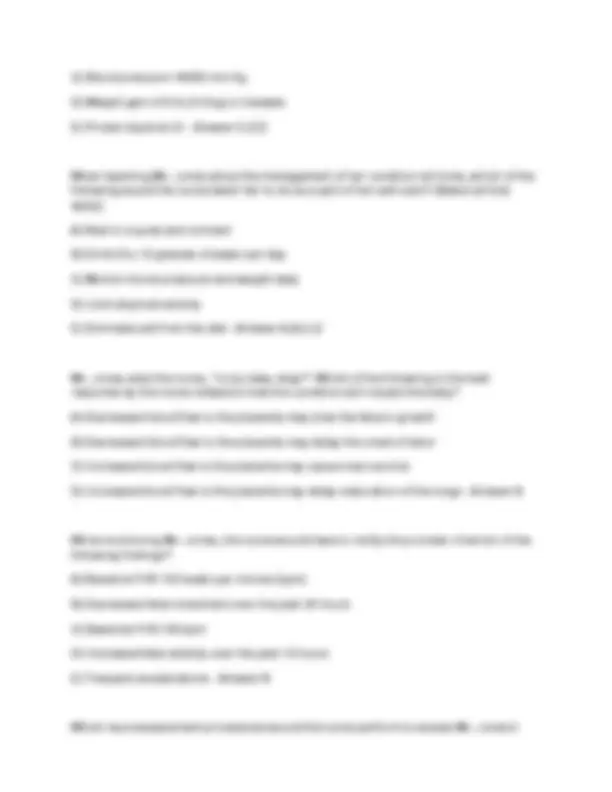
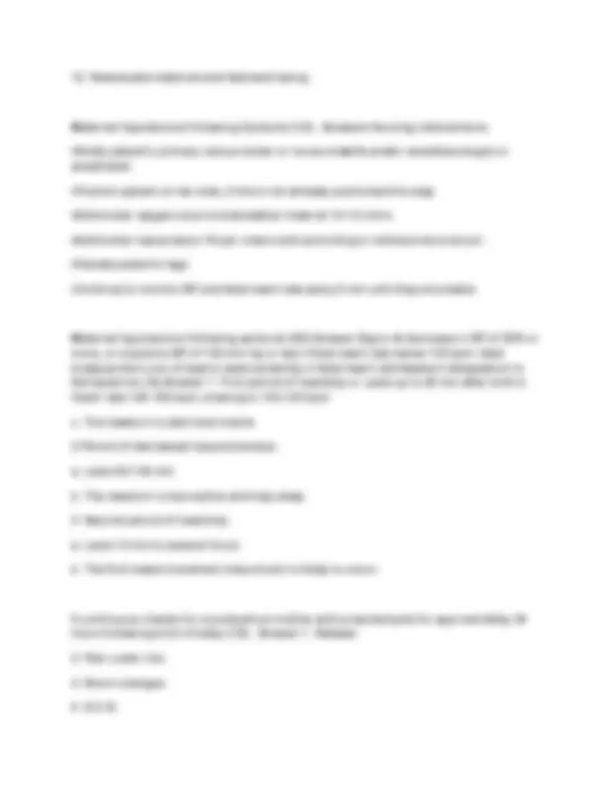



Study with the several resources on Docsity

Earn points by helping other students or get them with a premium plan


Prepare for your exams
Study with the several resources on Docsity

Earn points to download
Earn points by helping other students or get them with a premium plan
Community
Ask the community for help and clear up your study doubts
Discover the best universities in your country according to Docsity users
Free resources
Download our free guides on studying techniques, anxiety management strategies, and thesis advice from Docsity tutors
This resource offers a comprehensive collection of questions and answers about preeclampsia, a pregnancy-related hypertensive disorder. It explores risk factors, diagnostic criteria, clinical assessments, and management strategies. Questions cover pathophysiology, nursing interventions, and patient education, with detailed answers and rationales. It's valuable for students and healthcare professionals seeking to understand preeclampsia's impact on maternal and fetal well-being, enhancing critical thinking and clinical decision-making in obstetric care. Topics include fetal testing, edema assessment, blood pressure management, signs of worsening preeclampsia, fetal growth impact, neuroassessment, and patient self-care education.
Typology: Exams
1 / 9

This page cannot be seen from the preview
Don't miss anything!






Which of the following findings in a patient's prenatal history would be indicative to the nurse of a risk for developing preeclampsia? (Select all that apply) a) Asian ethnicity b) Body mass index less than 20 c) Low socioeconomic status d) First pregnancy e) African-American ethnicity - Answer C,D,E Rationale: Risk factors include first pregnancy, low socioeconomic status, poor nutrition, obesity, and African-American ethnicity. Low BMI and Asian ethnicity are not risk factors for preeclampsia.
While providing the discharge education for a pregnant woman with preeclampsia, the nurse would inform the patient that which fetal test will be done twice a week until the baby is born? A) Nonstress test B) Biophysical profile C) Fetal kick counts D) Lecithin-sphingomyelin (L/S) ratio - Answer A Rationale: A nonstress test is done to assess FHR reactivity to fetal movement and as an indicator of fetal well-being. If the nonstress test is nonreactive, a biophysical profile would be done. Fetal kick counts are done daily by the patient. An L/S ratio refers to a measure of pulmonary maturity and is not specific to care of the patient with preeclampsia.
During the physical examination the nurse discovers that the patient has swelling of the hands and feet. The nurse presses her finger against the edematous skin and gets a 4 mm indentation that takes 15 seconds to disappear. The nurse records A) 1+ pitting edema B) 2+ pitting edema C) 3+ pitting edema D) 4+ pitting edema - Answer B
Rationale:This finding exactly meets the criteria for 2+ pitting edema.
When the pregnant client is in which of the following positions does the nurse identify that the blood pressure measurement is lowest? a) Side lying b) Supine c) Sitting d) Standing - Answer A Rationale:A side-lying position has the lowest blood pressure measurements because this position displaces the weight of the gravid uterus from the major vessels, thereby decreasing resistance to blood flow.
Which of the following best describes the presentation of preeclampsia? A) Hypertension with proteinuria, which develops after 20 weeks gestation B) Hypertension with pedal edema which develops after 20 weeks gestation C) Hypertension with seizure activity after the 28th week of pregnancy D) Preexisting hypertension before pregnancy, with proteinuria developing before 20Wks gestation ANS A Rationale: Preeclampsia is a disease of the latter half of pregnancy, characterized by the presence of pregnancy-related hypertension and proteinuria. The development of seizures changes the diagnosis to eclampsia.
The patient's support person asks the nurse, "What kind of care will she need at home?" The nurse would tell the patient and support person that they need to monitor which of the following at home? (Select all that apply) a) Blood pressure twice a day b) Changes in fundal height c) Fetal movement d) Daily weight e) Oral temperature - Answer A,C,D
take her blood pressure. Which of the following is the best response by the nurse? A) Turn off the television so an accurate blood pressure can be taken B) Turn the patient on her left side, turn off the television, and return in 20 minutes to evaluate her blood pressure C) Instruct the patient to watch television and obtain her blood pressure in the supine position D) Obtain the patient's blood pressure in the supine position then encourage her to change her resting position - Answer B
The DTRs for Ms. Jones are documented as 2+. Which is the best interpretation by the nurse of this finding? A) Reflex within normal limits B) Reflex is diminished/hypoactive C) Reflex is increased/hyperactive D) Reflex is in the danger range - Answer A
Ms. Jones is receiving discharge instructions from the nurse about preeclampsia and how she will have to continue her care after going home. The nurse can advise her that she should call the provider if which of the following occur? (Select all that apply) A) Decreased fetal movement B) Visual changes C) Weight gain of 1/2 lb (227 g) per week D) Infrequent urination E) Epigastric pain - Answer A,B,D,E
A patient is admitted to the OB triage area with a working diagnosis of preeclampsia. Which of the following assessment findings are consistent with a diagnosis of preeclampsia? (Select all that apply) A) Nausea B) Fatigue
C) Blood pressure 146/92 mm Hg D) Weight gain of 8 lb (3.6 kg) in 2 weeks E) Protein dipstick 2+ - Answer C,D,E
When teaching Ms. Jones about the management of her condition at home, which of the following would the nurse teach her to do as a part of her self-care? (Select all that apply) A) Rest in a quiet environment B) Drink 8 to 10 glasses of water per day C) Monitor blood pressure and weight daily D) Limit physical activity E) Eliminate salt from the diet - Answer A,B,C,D
Ms. Jones asks the nurse, "Is my baby okay?" Which of the following is the best response by the nurse related to how this condition will impact the baby? A) Decreased blood flow to the placenta may slow the fetus's growth B) Decreased blood flow to the placenta may delay the onset of labor C) Increased blood flow to the placenta may cause macrosomia D) Increased blood flow to the placenta may delay maturation of the lungs - Answer A
While monitoring Ms. Jones, the nurse would have to notify the provider of which of the following findings? A) Baseline FHR 132 beats per minute (bpm) B) Decreased fetal movement over the past 24 hours C) Baseline FHR 160 bpm D) Increased fetal activity over the past 12 hours E) Frequent accelerations - Answer B
Which neuroassessment procedures would the nurse perform to assess Ms. Jones's
•Low socioeconomic status •Family history of preeclampsia •Nulliparity (first pregnancy) •Pregnancy with a new partner •Preeclampsia in a previous pregnancy •Urinary tract infection •Gestationa l diabetes •Type I diabetes •Obesity •Chronic hypertension (high BP that starts before 20 weeks' gestation; can accompany preeclampsia) •Kidney disease •Thrombophilia (an increased tendency to clot)
Sequence care for patient with preeclampsia in Labor and Delivery Dept. - Answer 1. Review patient history
Maternal Hypotension following Epidural (1/2) - Answers Nursing Interventions •Notify patient's primary care provider or nurse midwife and/or anesthesiologist or anesthetist. •Position patient on her side, if she is not already positioned this way. •Administer oxygen via a nonrebreather mask at 10-12 L/min. •Administer vasopressor IV per orders and according to institutional protocol. •Elevate patient's legs. •Continue to monitor BP and fetal heart rate every 5 min until they are stable.
Maternal hypotension following epidural (2/2)- Answer Signs •A decrease in BP of 20% or more, or a systolic BP of 100 mm Hg or less •Fetal heart rate below 120 bpm -fetal bradycardia •Loss of beat to beat variability in fetal heart rate Newborn Adaptation to Extrauterine Life-Answer 1. First period of reactivity a. Lasts up to 30 min after birth b. Heart rate 160-180 bpm, slowing to 100-120 bpm c. The newborn is alert and mobile. 2.Period of decreased responsiveness a. Lasts 60-100 min b. The newborn is less active and may sleep.
5 continuous checks for a postpartum mother with preeclampsia for approximately 24 hours following birth of baby (1/2) - Answer 1. Relexes